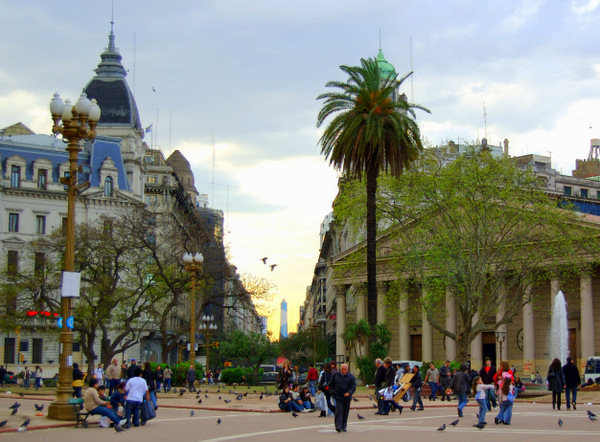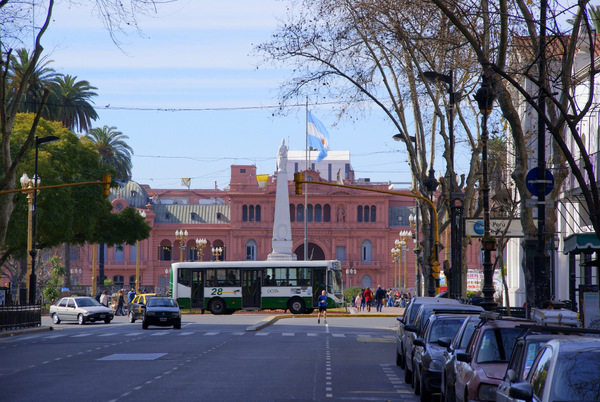- The Avenida de Mayo of Buenos Aires
Buenos Aires is, in many ways, a city of sensations. Passage through the city stimulates each of the senses: the sound of boisterous fútbol fans and seductive tango music, the sight of gorgeous murals and spectacular buildings, the smell of baking empanadas in the bakeries and restaurants, and the unique tastes of yerba mate and the Fernet con coca, are all guaranteed to dazzle any visitor who spends time here.
To an outsider these sensations might sound jarring, but Buenos Aires is a city that embraces its many contrasts. For examples of this, you can walk down the Avenida de Mayo, which passes through Buenos Aires’s busy Microcentro neighborhood and connects the National Congress with the Casa Rosada, home of the president. This avenue has been the site of countless parades and demonstrations during the great periods of change in Argentina’s history. Being such an important central part of the capital, the Avenida de Mayo has all of the city’s contrasts on bold display.
At the beginning of the avenue, visitors are stunned by the smooth and rippling façade of the Palacio Barolo, constructed by the Italian architect Mario Palanti. The building is modelled on the three stages of Dante Alighieri’s epic The Divine Comedy. Palanti’s original intent was for the lighthouse to serve as a new resting place for the famed poet’s ashes, and while this plan never came to fruition, he did construct a twin building in Montevideo, and the light of each lighthouse can be seen from the other.
Moving on down the avenue, you will see lower buildings with French and Italian façades, and you likely will see street vendors selling mate gourds and pungent sticks of palo santo and various other curios. Eventually you will reach the intersection of this street and the Avenida 9 de Julio, which has the distinction of being the widest avenue in the world.
At the intersection of these two streets you will be greeting by a monument to the literary character Don Quixote, cast in bronze astride his cock-eyed steed Rocinante. As you cross, to your left you will see the majestic white Obelisco, icon of the city, and to the right you will see the Edificio del Ministerio de Salud with its thirty-meter-high portrait of Eva Peron, the former first lady who holds a saint-like position in Argentine history.
If you are passing through with friends, this would be a good place to sit on a bench, share some mate, and take in the city’s heartbeat as the roaring traffic passes through this central artery.
As you continue on the Avenida de Mayo on the eastern side of 9 de Julio, you may notice larger and more modern buildings, as there are many large banks and businesses on this side. As fits the city’s love of contrast, these sleek towers are squeezed alongside buildings of the elaborate neoclassical French and Italian styles and the more ergonomic German and English styles.
You will also pass the Café Tortoni, which boasts a century and a half of hosting tango shows and catering to the artistic and literary elites, including Carlos Gardel, Jorge Luis Borges, and the Spanish poet Federico Garcia Lorca. If you stop for a coffee and medialunas, you can view its paintings, sculptures, and artifacts of Argentina’s artistic golden age.
Before you reach the end of the Avenida de Mayo there remains one key sight, a veritable microcosm of the city’s bustling lifestyle: the Calle Florida. Unlike the broad avenues you’ve seen before, Calle Florida is a pedestrian street which cuts through Microcentro, lined with such a wide variety of stores that it serves as an outdoor mall.
Throughout the day you can see people bustling among every imaginable variety of shop, and among them you may see local bands and musicians busking, tango dancers drawing crowds, and independent vendors selling a variety of goods from their blankets on the sidewalks. An exploration of Calle Florida and its adjacent Galerías Pacífico is an adventure that could take up an entire day on its own.
At the end of the Avenida de Mayo, the cluster of buildings opens out in the Plaza de Mayo, a broad and beautiful area leading up to the Casa Rosada, where along the palm-lined streets no-nonsense modern architecture sits beside antique colonial structures. At the center of the plaza, the presidential palace is an asymmetrical neoclassical wonder sure to impress any visitor or expatriate.
All of these sites are to be found in the area of just one street of Buenos Aires. The city has many more to offer, and the tourist may feel overwhelmed with trying to take it all in. This, however, should be counted as a blessing. You’ll never run out of sights to marvel over in Argentina’s capital.
article by Cameron Kobes
===================================












 Hi! I'm Lash, an American nomadic world traveler who's been traveling solo since 1998. I’m passionate about traveling the world nomadically and then sharing it all with you. I hope to inspire you to travel the world, to entertain you with tales from the road, and to help you reach your travel dreams. Welcome!
Hi! I'm Lash, an American nomadic world traveler who's been traveling solo since 1998. I’m passionate about traveling the world nomadically and then sharing it all with you. I hope to inspire you to travel the world, to entertain you with tales from the road, and to help you reach your travel dreams. Welcome! 



